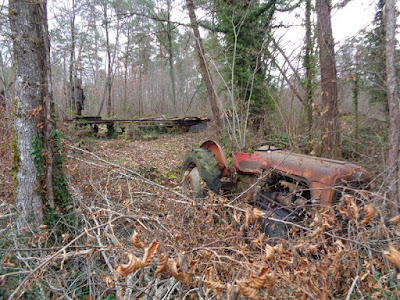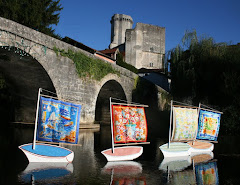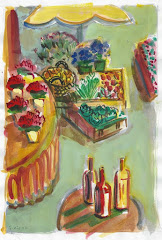Tuesday, February 16, 2016
Stories to be Told
There are stories to be read from the winter landscape. Chapters unfold while ambling along a country path. A perfect adventure includes sunshine, big vistas, charming hamlets and at least one dreamy chateau. With no leaves to hide the setting and scenes fantastically illuminated by the low angle of the winter sun who knows what the story will be; a mystery, a romance or maybe historical fiction……
At the start today’s adventure was anything but perfect - or was it?
Gathering under streaks of pink and gray clouds, we were not sure if the sun had enough force to sweep them away. Everyone had good boots and an umbrella at hand. Dry shoes and socks were stocked in the trunk for our return at the end of the morning’s loop. A loop that took us around a village just up from Bourdeilles’ river valley. St Julien de Bourdeilles sits up hill on the edge of a large flat plateau.
The plot started blandly. There was an old church (of course) with ten or so homes nestled around it. A few twists and turns later we were crossing farmer’s fields. The most noticeable feature on the walk seemed to be the stone walls. And then it turned out that indeed the most exciting part of the walk were the stone walls. With nothing dramatic on the horizon to distract us from what was right alongside we began to pay attention to what hemmed us in-- miles and miles of crisscrossing stone walls.
There was a story to be read on this expansive plateau, we just had to take turns reading the chapters. This was not going to be a swashbuckling, romantic adventure, but a gentle tale of rural life. Life hard-earned and precarious.
The sinewy sturdy stone walls tell of months, years, of the Sisyphean task of clearing rock strewn fields. Stones that grow in a field without any effort on the farmers part - except to annually harvest them on bleak winter days. How lucky that the stones could serve a dual purpose, a winter occupation and walls to hold in grazing livestock.
We’ve picked up the rhythm of this classic farm story. The plateau was once animated by bleating sheep and the raspy scrape of a plow. Once or twice a year the farmer would head off to market. Heading down valley along these paths carefully laid out between the stone walls.
This chapter has it’s mysteries. How many folks have walked these paths? Were there people passing through from the farthest reaches of France? Where were they going? What had they seen along the way? The path is often too narrow for two people to pass side by side and the walls stand as high as our shoulders. What would have happened on the rare occasion when two carts would meet along the path? We laughed at the idea of a farmer trying to convince a goat to back up.. We felt for the driver having to deal with this unexpected, aggravating encounter. Walls can be shoulder high for many long meters and there were no lay-bys to help out.
Another thing about these path was not so much a mystery as a marvel. If one pays close attention you can see that the stones underfoot are not just natures random toss, but have actually been placed one by one like paving stones. Apparently rainy winters and muddy paths have long been a problem here. More fascinating, parts of the rock path seemed to be precisely cut by a mason. In fact it is a perfectly long table exactly as wide as a set of train wheels, which is the same width as the farmers’ carts that carved this rock over hundreds of years.
There has been tragedy in the long course of our story. We won’t see a single sheep, the farm houses we pass are shuttered or falling in, and here and there the stone walls have succumbed to gravity and tumbled onto the path. Trees are filling in land once so carefully cleared.
By the looks of the scrawny trees trunks the sheep have not been gone all that long from the pastures. By contrast the pillowy clumps of emerald green moss would make one think the walls have been here forever.
Behind the walls trees are strewn like pick-up sticks. In an ancient setting this is a recent drama. A tempest passed across France at the changing of the millennium and left the scars of her fury. Solemnly standing among the downed trees we can see the craggy, dead trunks of once enormous chestnut trees. These ruins tell the older story of when the chestnut blight wiped out an entire chunk of the forest habitat. Their loss was another blow to the settlers’ meager resources.
We closed up our loop and changed out of soggy shoes. Today there will be no story of a fairy princess in her hidden castle tower, no knights in shinning armor. We finish off this country story at a mill. A mill where our farm character might have stopped after walking behind his goat cart along the the miles and miles of stone walls. Or maybe, like us, our farmer had a wandering spirit and he continued on down more miles and miles of walls that led to who knows where. And maybe it’s in the who knows where that we will find some adventure in our stories.
Tuesday, February 2, 2016
Precious as Gold
Love of walnut oil is not something new to the gentle folks of the Perigord region of France. Roman settlers carefully brought along and planted a variety of a walnut tree that the Egyptians had cultivated. The clever Egyptians had cross-bred trees until they developed a walnut with “meat” that was rich enough in fat to be pressed for oil. The mighty walnut even earned itself it’s own proverb: “Rien n’est perdu dans la Noix du Périgord sauf le bruit qu’elle fait en se cassant” Nothing is lost of the Walnut of the Perigord except the sound that she makes when she cracks.”
Loving order and precision in all things, the Romans planted every orchard in a square 11 meters x 11 meters. Todays orchards are still laid out in this military fashion..
Walnut oil was considered as precious as gold well into the 1700’s. It is an oil that brought great fortunes to the Dordogne region. It’s multiple uses made it a sought after commodity. The oil was used for lighting lamps, mixing paints and making soft soaps, but most importantly for cooking. (Now a days we say it has too low a burn point to cook with, but back then one used what could be produced locally and free.)
Just one or two trees on a small farm could help a peasant pay off their debs. Large land owner’s orchards brought great riches to their properties. Nobles and clergy alike made sure that an orchard of walnuts was planted on their holdings.
The production of walnut oil really took off in the 17th century. Like the wines of southern France, barrels of oil passed through Bordeaux to Holland, England and Germany. Not only the oil was shipped, but the nuts themselves and the valuable trunks of old trees were also loaded on ships. Seasonal markets sprung up in late fall where everyone brought their harvest to a central location to sell to millers who then processed the nuts in their riverside mills.
During the 20th century walnut orchards had difficult times. Millers went off to war and did not return, their knowledge lost with them. The regimented rows of walnut trees were cut down because the strong wood was perfect for making gun handles. World War I, and then WWII, ate up men and trees.
Luckily in the 1950’s there was a push to plant new walnut orchards. Old timer’s memories were picked to reconstruct the best methods for growth and production.
Walnuts are gathered in late October and left for a month or so in a sheltered space to dry. Some folks then take sack-fulls to the local cooperative to be sold by the kilo - shell and all, for a little “mad money”. In days gone by entire hamlets and villages would get together on long winter evenings for nut cracking. Now a days a few families still work together around the kitchen table to crack their own nuts, but for a big operation like our local mill the nuts are shelled by a machine. This past year the nuts had a lot of disease, so there was a lot of hand sorting of the good meat from the bad. Some things machines just can’t do. Sacks of the precious morsels are then transported down to the mill. Here the millers work their age old magic, magic passed on from generation to generation. The bottled gold is shipped off all over the world and few will know, but all will taste, the long and rich history of the Walnut of the Perigord.
Subscribe to:
Posts (Atom)


























